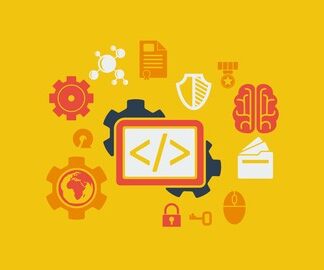
If you find yourself needing assistance at any point throughout the tutorial series, feel free to enroll in The Complete Ethical Hacking Course Bundle for 1 on 1 help!
https://josephdelgadillo.com/ethical-hacking/
Below is a list of the courses included in the bundle:
The Complete Ethical Hacking Course for 2018!
http://bit.ly/2leW0j4
Certified Ethical Hacker Boot Camp for 2018!
http://bit.ly/2yKbler
The Complete Ethical Hacker Course: Beginner to Advanced!
http://bit.ly/2i3kirq
Build an Advanced Keylogger for Ethical Hacking!
http://bit.ly/2yMl3gI
Hello everybody and welcome to this tutorial. Today, I will continue with the installation of Kali Linux within a virtual environment.
You may have noticed that I have two screens on which is written Kali Linux, and they are exactly the same except one has a bigger font and a zoomed in picture. So over here, on the left side, this is my virtual machine. The window which I’m moving now is the actual virtual machine, and the window on the right side is just a zooming in app that I have installed in order for you to be able to better see what I am about to show you here. I do not have guest additions installed on the virtual machine, and you cannot install it until you have actually installed the operating system. I will perform the work there, on the left side, and you can monitor what I am doing on the right. There is no difference between left and right in terms of actions, only in terms of font size.
Anyway, I’m just going to go ahead and scroll down to install, press ENTER, and the installation procedure will commence. By the way, if you boot into the live version, the default password for root is just root in reverse, so toor. Just a bit of a brief mention there. Moving along, pick whatever language is suitable for you. You can also pick the uppermost option where it says C, no localization. So if you would prefer a greater degree of anonymity, you can even pick that. But for the sake of this tutorial, there really isn’t a need. If you do pick a language, and I mean a lot of people choose English, you will not be leaving much of a footprint. Press ENTER and here you can choose a country, territory, or area. You can choose whatever you would like here. I’m just going to go ahead and click UK because it immediately offers me a British keyboard that I use, so that’s very nice in terms of settings. In any case, even if you do not choose the correct setting here it doesn’t matter. Later on, after the installation, you can configure it any way you like.
The installation is now underway. I’m going to unbind my mouse because it seems to get stuck in a loop there. Basically, you bind and unbind your keys by simply pressing the right control key. Let me just move this a bit so you can see it a bit better, expand, there we go. There’s some auto configuration going on now, nothing really noteworthy. Let me just change this a bit. There we go. You can pick a host name here. You can just leave it as default, you can leave Kali, or you can actually write whatever you want your computer to be called. So, I’m just going to leave it as the default, but as I said you can write whatever you wish to write there. So, just go ahead and continue. By the way, you don’t have a mouse option here while you’re performing this installation, so pressing tab switches between fields and options. Pressing space allows you to mark the field, and tab means switching fields. So use tab, space, and enter to actually call a function to execute something. I’m going to select continue. Here you can type in your domain name. No, I do not want a domain name at this time. Keep in mind that you can configure this later on as well, should there be a need for it. Just click on continue or hit enter.
Now for the root password I would suggest picking something ridiculously complex and complicated. A lot of people worry that they won’t remember their passwords if they’re long and complicated, but assign a certain logic to your password. Something that reflects the way you think. And then the password can increase in length, and you you will still manage to remember it. So, for example, you can insert a certain word that you use, or that you’re attached to, or something like that. You don’t need to spell the word correctly in the English language, rather instead you can spell it incorrectly and then add exclamation marks, question marks, greater than signs, less than signs, ampersands, and so on. But choose something that reflects your logic, your way of thinking, and make sure that it is more than eight characters. Greater than eight characters is a must-have. It needs to contain capital letters, a few of them not just one. You also need multiple different signs. You should use three or four of them in combination. The more the better. Don’t just type in a word in the English language, and then type in numbers, and then type in signs. You are already assigning a very strict order, so, any brute-forcing attack will go much easier. Try to have a mixture, try to randomize the position of the types of characters that you’re going to put in your password. For the time being, for the sake of this tutorial, I’m going to use one of the dumbest passwords possible. I’m going to type in test. That’s gonna be the password of this virtual machine, and I’m going to hit the continue button. It’s going to ask you to verify it by forcing you to re-enter it, and there we go. But once again I emphasize to use a strong password.
So now we have partitioning methods. If this was my main machine, if this was my host machine, I would definitely do this manually. I would want my partitions to be configured in a certain way. But since this is a virtual machine, I’m just going to go ahead and say guided, use entire disk. It doesn’t matter to me as there is only one partition anyway, and it’s 138 gigabytes. Press Enter. All files in one partition recommended for new users. Sure, we can do that. You can separate the home partition, you can separate all of these partitions. For example, this is something that I did on my host machine. You have a lot of things that are separate, and my main drives are also full fully encrypted. So, even if I lost my laptop, or it got stolen, it would be really difficult to access pretty much anything. Even the BIOS is locked, so you can’t even reinstall it. You would have to open up the laptop, take the BIOS battery out which is underneath my main processor, and you’re more likely to basically permanently damage the motherboard than you are to actually remove and put back the battery in order to reset the BIOS. That’s one of the very nice fail safes for devices, especially for compact laptops. But, in this case, we don’t need any of that. Such configuration and such things are generally done on the host machine. You encrypt your partitions there, you lock the BIOS there, and so on.. While on the other hand, with virtual machines there’s no need to do anything of a kind. The host machines are the fail-safe. If that fails, everything else will fail. So, you don’t need to worry about it, you don’t need those unnecessary layers I would say. They will slow you down in the greater scheme of things. So, press enter, finish partitioning, and write changes to disk. Before I do that, let me just go ahead and explain our partitioning layout here. So you have primary, #1 primary 126.5 gigabytes, space f, space ext4 space /. Now all these things have a meaning, but what you need to know is that like in Windows you have NTFS partitions, in Linux you have ext4 partitions. They are a bit faster, that’s one thing that goes in the favor of Linux, and during the partitioning of the disk, with a Linux system, there is only one partition which is a must-have, which is an absolute requirement, and that is this first partition that I have selected. It’s notation is just a slash, that is the root partition, and you always need to configure it, always. Without it manual partitioning will not work, you will get error messages saying that you must specify a root partition.
Down below we have swap. Swap is basically a fail-safe method. So when you run out of RAM memory you basically tell your system OK, you can have this portion of the hard drive, and you can use it as RAM, which functions in a very slow manner, but it will prevent your machine from crashing. Usually, swap partitions are configured to be double the size of your RAM. My RAM is 8 gigabytes, but here the computer has been assigned 4 because this is a virtual machine, and if you remember at the beginning I have assigned 2 gigabytes of RAM to this virtual machine. So, it just multiplied it by 2. It wasn’t exactly 2, it was just above 2, so I get 4.3 gigabytes of swap space. Now on most of the modern systems, on most of the modern computers, you will not require swap partitions. If you don’t make it you’ll get a warning, but rare are the cases when you will need a swap partition, when you will waste all 8 gigabytes of RAM. I mean it happens to me from time to time, but usually if it happens there’s something wrong with the system, and I don’t want it to continue consuming resources. I want it to stop there.
Anyway, now that you know what some of these options here mean, you have notation for the disk here, it’s SDA. But, we’ll get into that later as we configure the system. So you also have some other options here. It says configure encrypted volumes, configure logical volume manager, (LVM), configure raid, and you can go back to guided partitioning. So these are all very nice options that come for free, and you might think oh, well, that’s no big deal, but believe me when I tell you these things, in proprietary operating systems, they cost a lot of money. While here they are free, and generally work better. What we will be interested in today will not be raid, because we don’t actually need it. You can configure encrypted volumes as well. I will demonstrate this at a later time, encryption methods. You don’t need to encrypt your volumes on a virtual machine, but you can encrypt certain files or folders if you don’t want to grant access to them. However, my hard drives here on my host machine are encrypted, so I am pretty safe in that regard. I’m just going to go ahead now to the bottom, press enter, and finish partitioning, and write changes to disk. Excellent! Let me just move this a little bit so you can see it. Basically, it is asking me for a confirmation, so if you continue the changes listed below will be written to disk. Otherwise, you will be able to make further changes manually. Now it is informing me of the changes to be made and telling me, basically, that all the information will be lost should there be anything there. So write changes to disks, yes. Go ahead and continue with the procedure. The installation process is now underway and this is going to take a while. So, while this is going on I just want to go ahead and pause the video here and finish this tutorial. In the next tutorial, once the installation is complete, I will actually get into Kali, start configuring it, and introduce you to it’s interface. In any case, I bid you farewell, and I hope to see you all in the next tutorial.
The remainder of the tutorial videos can be found in this YouTube playlist:
You can also enroll in the course and download the videos for offline viewing:
https://jtdigital.teachable.com/p/hacking-free/
Subscribe on YouTube – https://www.youtube.com/c/JosephDelgadillo?sub_confirmation=1
Follow on Steemit – https://steemit.com/@jo3potato









